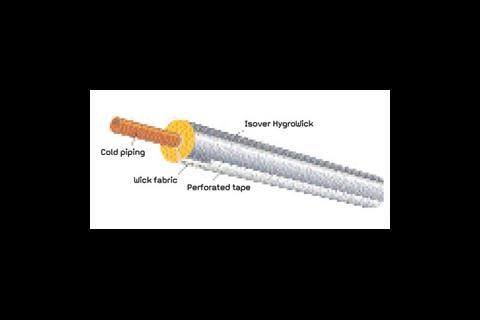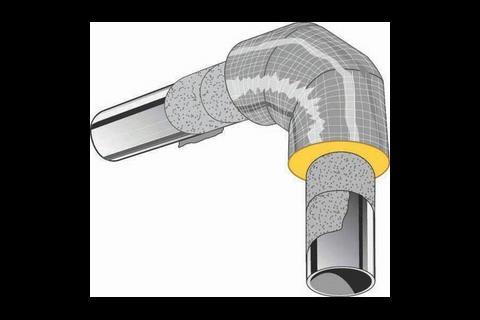Insulation on cold piping is dogged by problems with condensation. As Vit Koverdynsky, Vagn Korsgaard and Carsten Rode explain, one solution is to use self-drying insulation, based on wicking
Unlike traditional insulation, wicking insulation can be installed on systems that are in use, even if the pipes are cold, wet and corroded, so the cooling plant does not have to be turned off during installation.
It has other advantages, too. It uses insulation made from glass wool, which is non-flammable and is made of up to 80% recycled glass, and can itself be recycled. And, because the material is cheap, an increased thickness is often used, which means more energy can be saved than in a traditional pipework insulation system.
For an existing system, if a cold or chilled water pipe has no insulation and its surface temperature is below the dew point of the ambient air, then water vapour will move from the ambient air to the cold pipe where it will condense to form drips.
To prevent condensation, cold pipes are normally enclosed in thermal insulation. This must be thick enough to ensure the temperature of the outer surface of the insulation is above the dew point of the ambient air.
However, even if the thickness of the insulation is adequate, water vapour will still migrate towards the cold pipe, which will result in moisture accumulation in the insulation. This can be minimised in several ways: by installing a vapour retarding layer; by using insulation with low permeability to give a high water vapour resistance; and by using a capillary fabric to transport condensed water continuously from the pipe surface to the atmosphere.
In practice, poor workmanship means it is often impossible to make insulation 100% vapour-proof. And, even if it were, it is likely that, over time, damage to the insulation would allow water vapour to enter the insulation. The advantage of wicking insulation is that it works even if condensation builds up on the pipe surface.
How wicking insulation works
Wicking insulation for cold pipework uses capillary action to remove moisture from the surface of a cold pipe by transporting it to the outer surface of the insulation where it can evaporate. This is why it is sometimes called self-drying insulation.
The system was conceived by Professor Vagn Korsgaard of the Department of Buildings and Energy at the Technical University of Denmark in 1993. Korsgaard established that moisture could be moved from the pipe surface to an area of lower moisture by wrapping the pipe in a wicking fabric, such as glass fibre cloth. This fabric extends into a slot through the insulation, and is then attached to the outside of the insulation, as shown below.
For horizontal pipes, the longitudinal slot should preferably be placed facing downwards to allow gravity to help remove the condensed water.
As long as the dew point of the ambient air is lower than the surface temperature of the insulation jacket, moisture will evaporate to the ambient air.
If the dew point is equal to, or higher than, the surface temperature of the jacket, then condensation will begin to form on the jacket and the protruding wick fabric, and dripping may start.
However, even when condensation is starting to form on the pipework insulation jacket, condensed water vapour will continue to drain through the wick fabric by gravitation and the insulation will stay dry, as long as the pipe and air temperatures are above freezing.
The slot in the vapour retardant jacket through which the wick fabric protrudes could be considered a flaw in the insulation. However, vapour pressure prevents water vapour diffusing through the slot, as a quick explanation will make clear.
At start-up, when the wick is dry, there will be a vapour movement from the room air to the cold pipe. If the room conditions are 22 °C, 60% RH, vapour pressure is 1580 Pa, and the temperature of the pipe surface is 6°C, the pressure in the gap is 930 Pa.
The vapour pressure difference will be 650 Pa.
After a few days, the wick fabric will become moist, and the vapour pressure in the gap will increase to almost saturation at room temperature, which is 2630 Pa. This means there will be a drying potential from the protruding wick towards the room air and, therefore, water vapour from the room air cannot diffuse into the slot in the jacket.
The longitudinal joint should be sealed with perforated aluminium tape when rooms suffer from high temperatures and high relative humidity. This will slow down the diffusion of water vapour towards the cold pipe.
If the tape is not applied, more moisture could get into the system than it can cope with and water vapour could bypass the wick and diffuse through the porous insulation.
Installation instructions
The self-drying system is designed for insulation on cold or dual temperature pipework operating at temperatures from 0 to 80 °C in buildings or industrial facilities.
Care must be taken during installation to ensure the wick material stays in place during the alignment of the insulation sections. Pipe sections should be tightly butted together and secured to each other with aluminium tape, in the same way traditional glass wool pipe sections would be installed. No glue is needed as an absolutely tight vapour barrier is not necessary. All self-drying insulation system terminations should be sealed with aluminium tape.
The recommended thickness of insulation to prevent surface condensation must be installed.
Self-drying insulation can be applied on new and replacement jobs. Unlike traditional insulation, this system may readily be installed on systems in operation, even if the pipes are wet or slightly corroded. However, caution is needed on severely corroded pipe sections as this may cause improper insulation fit, which could overload the wicking system. Rust and scale should be removed from such pipes before installation.
Flanges, fittings, valves and hangers must have field-applied wick fabric wrapped in place to ensure a continuous connection.
The system can also be used on vertical pipework. To ensure that vertical installations perform as designed, the longitudinal joint (evaporation area) should be sealed with aluminium tape to prevent the chimney effect drawing in moist ambient air.
Moisture from the vertical risers will be drawn by the wicking fabric to evaporate at the lowest horizontal parts. This means it is necessary to create a continuous wick path by wrapping all vertical parts with wick fabric.
If there is no horizontal section or a horizontal pipe section with less than 150 mm of open evaporation area, one solution is to create an evaporation area for 100 to 150 mm at the bottom of the riser. Another possibility is to enlarge the evaporation area.
The concept can also be used outdoors, but it is not suitable in countries where there are long, cold winters as freezing outside air temperatures will cause the moisture in the wick fabric to freeze, which would be followed by ice growing in the insulation.
Experiments
Experiments were carried out in a laboratory at the Technical University of Denmark in Copenhagen to prove the system’s effectiveness. Four horizontal environmental chambers, a vertical chamber and two cooling plants were used for the tests.
In each horizontal chamber, there were two cold pipes. In order to create a flow inside single-ended pipes, each one consists of two concentric pipes, where the inner pipe functions as a return pipe. This “cold finger” arrangement allows for the periodic removal and weighing of the pipe sections to determine the weight change caused by water vapour ingress.
Testing was conducted in environmental chambers with controlled temperature and relative humidity. To keep the humidity constant, a NaCl saturated salt solution was used, which has an equilibrium RH of 75 %.
Example of experiment and results
The experiment used two 1” diameter black pipes, which were covered with 0.6 m long sections of insulation, with an outer diameter of 92 mm. The insulation was 30 mm thick, and the ends of the insulation pipe sections were covered by a PVC annulus, and were sealed by caulking.
The samples were weighed and then placed on the cold finger. The cold finger was maintained at a set temperature, typically 5 °C, and the test lasted for two months. In order to have wicking action from the outset in one of the samples, its wicking fabric was wetted by distilled water to ensure the wick fabric was fully saturated. The other sample was installed dry.
As illustrated in the graph on the facing page, the dry pipe had a rapid weight gain within the first two days of testing. Afterwards, the weight of the sample remained constant. This is consistent with the assumption that an initial period of water accumulation must occur prior to saturation of the wick. During this initial transient period, there is no liquid water at the slot.
In contrast, the pipe that had a wet wick fabric installed began to remove condensed water through the slot to the evaporation area immediately. After three days, the flow of water vapour diffusion into the system equalled the flow rate of liquid water out of the system, and a state of equilibrium was reached.
The data show that the weight gain during the initial transient period is roughly 5 to 6 g per pipe section. If the wick fabric had been fully saturated, the weight gain should be 15 g per pipe section.
From this, it can be concluded that the weight gain measured is confined to the wick material (it means the insulation is dry); and the material is less than 50% saturated.
After 16 days, the wick fabric was wetted again by adding a further 6 ml of water. Within three days, the moisture content of the wick fabric had returned to the level it had been at before it was made wet.
At day 21 and day 24, the wick fabric was wetted again with 6 ml of water, but now the pipe section was turned so that the slot faced upwards. As can be seen from the graph opposite, the wick still works without the help of gravity.
The experiment proved that self-drying insulation worked successfully to prevent the accumulation of moisture in glass wool insulation. The experiment also showed that the insulation remains dry and so maintains its initial thermal conductivity, and the amount of moisture in the wick was less than 50% of the moisture content if the wick was saturated.
The recommended position of the pipe section is the slot-down configuration, but the experiment showed that the system also works in slot-up configuration. This is because the capillary suction forces of glass fibre fabric are strong enough to suck the moisture without the help of gravity.
The experiment proved that the concept is effective and that it has a drying ability several hundred times greater than the speed at which moisture is added, so the system should still work even with a damaged surface or less careful workmanship.
Downloads
Weight gain over time during the experiment
Other, Size 0 kb
Source
Building Sustainable Design
Postscript
Vit Koverdynsky is at the Institute of Building Services at Brno Technical University, Czech Republic; Vagn Korsgaard and Carsten Rode are in the Department of Civil Engineering at the Technical University of Denmark in Lyngby




























No comments yet